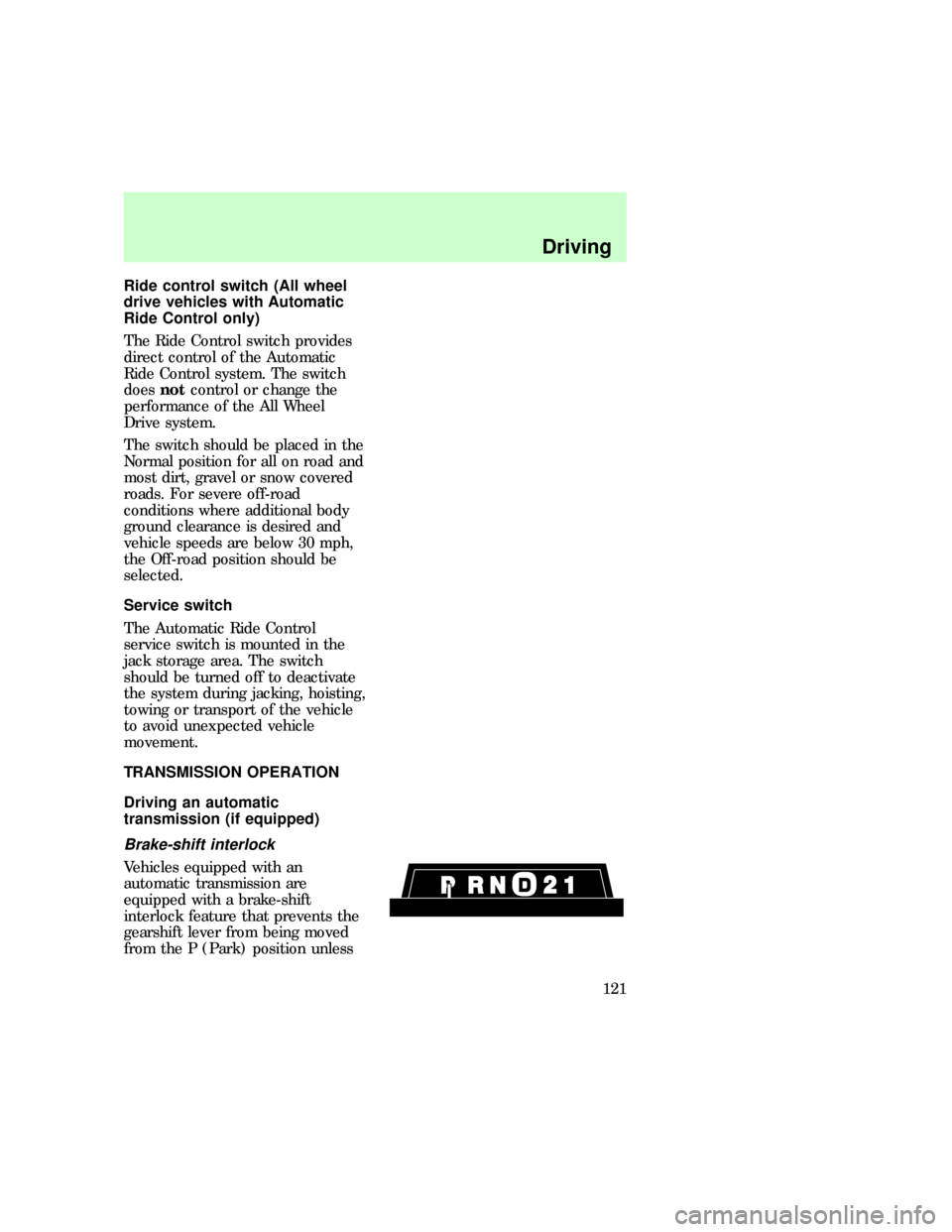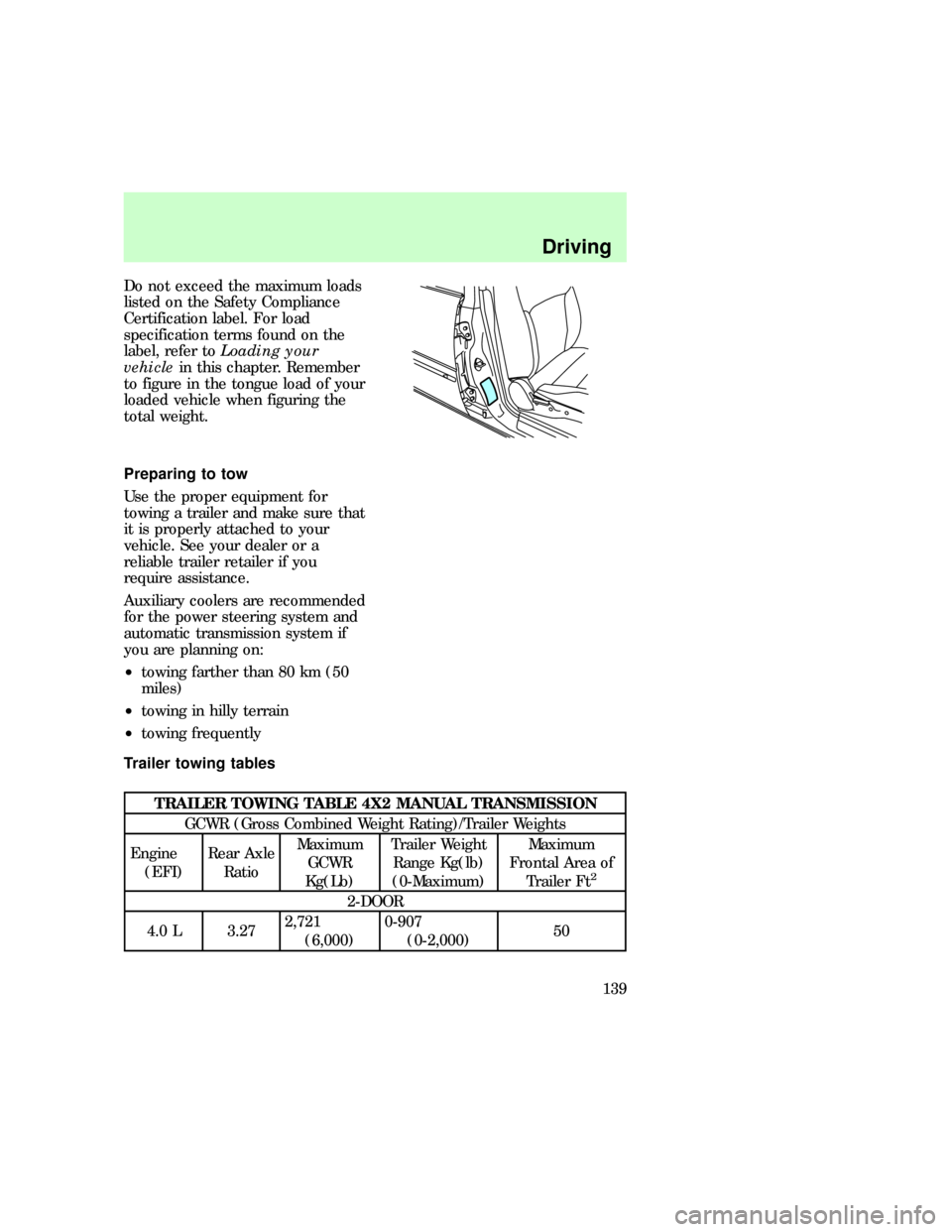Page 37 of 236
Wipers
For rear wiper operation, rotate
the rear window wiper and washer
control to the desired interval
position.
Automatic ride control
(if equipped)
Your vehicle is equipped with an
automatic ride control system. This
system is designed to level your
vehicle when towing or carrying a
heavy load.
To prevent sudden vehicle
movement, turn off the air
suspension switch prior to jacking,
towing or hoisting the vehicle.
4WD CONTROL (IF EQUIPPED)
This control operates the Control
Trac 4WD. Refer toControl trac
systemin theDrivingchapter for
more information.
020
1030405060
70
80
90
110
120000000ooookm/h10020406080100
120
140
160
1800P RND21UNLEADED
FUEL ONLY
RPM x 100012345
6H
C
FERSM
SET
ACC
COAST OFF ONOFF
SRSHI LOOFF*A/C*MAX
A/C
REW
1FF
2SIDE 1-2
3
FM 1STVOL – PUSH ON
AM
FMBASS TREBBAL FADE
AUTO
SET CLKSEEKTUNE
DISCSSCAN4DOLBY SYSTEMEJTAPE CDCOMP5SHUFFLE
6
PUSH
OFFHIR. WIPE
PUSH
uno_4wd_switch
uno_fuel_pump_shut_off_ref
Controls and features
38
Page 120 of 236

Ride control switch (All wheel
drive vehicles with Automatic
Ride Control only)
The Ride Control switch provides
direct control of the Automatic
Ride Control system. The switch
doesnotcontrol or change the
performance of the All Wheel
Drive system.
The switch should be placed in the
Normal position for all on road and
most dirt, gravel or snow covered
roads. For severe off-road
conditions where additional body
ground clearance is desired and
vehicle speeds are below 30 mph,
the Off-road position should be
selected.
Service switch
The Automatic Ride Control
service switch is mounted in the
jack storage area. The switch
should be turned off to deactivate
the system during jacking, hoisting,
towing or transport of the vehicle
to avoid unexpected vehicle
movement.
TRANSMISSION OPERATION
Driving an automatic
transmission (if equipped)
Brake-shift interlock
Vehicles equipped with an
automatic transmission are
equipped with a brake-shift
interlock feature that prevents the
gearshift lever from being moved
from the P (Park) position unless
uno_service_switch
uno_transmission_title
uno_driving_an_automatic
uno_brake_shift_interlock
Driving
121
Page 122 of 236

towing a trailer or heavy loads
through heavy terrain.
To return to
D(Overdrive)
mode, press the transmission
control switch.
O/D
OFFwill remain off.
When starting your vehicle, the
transmission will automatically
return to normal
D(Overdrive)
mode.
2 SecondUse the 2 (Second)
position to start-up on slippery
roads or to provide additional
braking on downgrades.
Transmission operates in gears one
and two.
1 LowUse the 1 (Low) position to
provide maximum engine braking
on steep downgrades. Upshifts may
be made by shifting to the 2
(Second) position or to
D(Overdrive). Selecting the 1
(Low) position at higher speeds
causes the transmission to
downshift through the gears and
will shift to 1 (Low) after the
vehicle decelerates to the proper
speed.
Driving (5R55E
transmission-4.0L engines only)
DOverdriveThe normal driving
position for the best fuel economy.
Transmission operates in gears one
through five.
Dcan be deactivated by pressing
the transmission control switch on
the selector lever. The
O/D
OFFwill
illuminate.
uno_5r55e
Driving
123
Page 123 of 236

D DriveNot shown on the display.
Activate by pressing the
transmission control switch.
O/D
OFFwill illuminate in the
instrument cluster. Transmission
operates in gears one through four.
D (Drive) provides more engine
braking than
D(Overdrive) and
is useful when towing a trailer or
heavy loads through heavy terrain.
To return to
D(Overdrive)
mode, press the transmission
control switch.
O/D
OFFwill turn off.
When starting your vehicle, the
transmission will automatically
return to normal
D(Overdrive)
mode.
2 SecondUse the 2 (Second)
position to start-up on slippery
roads or to provide additional
braking on downgrades.
Transmission operates in third
gear.
1 LowUse the 1 (Low) position to
provide maximum engine braking
on steep downgrades. Upshifts may
be made by shifting to the 2
(Second) position or to
D(Overdrive). Selecting the 1
(Low) position at high speeds
causes the transmission to
downshift through the gears and
will shift to 1 (Low) after the
vehicle decelerates to the proper
speed.
uno_driving_manual_trans
Driving
124
Page 135 of 236

²GAWR (Gross Axle Weight
Rating) ÐCarrying capacity
for each axle system (front and
rear). The GAWR is specific to
each vehicle and is listed on the
Safety Compliance Certification
Label on the driver door pillar.
²GCW (Gross Combined
Weight) ÐThe GCW is the
maximum combined weight of
the towing vehicle (including
passengers and cargo) and the
loaded trailer. The GCW is
specified by the manufacturer to
indicate the combined maximum
loaded weight that the vehicle is
designed to tow.
Payload = GVWR minus Base
curb weight
To obtain the correct weights for
your vehicle, try taking your
vehicle to a shipping company or
an inspection station for trucks.
Do not use replacement tires with
lower weight capacities than the
originals because they might lower
the vehicle's GVWR and GAWR.
(Replacement tires with a higher
weight limit than the originals do
not increase the GVWR or the
GAWR limitations.)
In high altitudes, engines will lose
power at a rate of 3% power per
300 m (1000 ft) increase in
elevation. A reduction in GVW and
GCW is recommended for
maximum vehicle performance.
Driving
136
Page 137 of 236

TRAILER TOWING
Trailer towing with your vehicle
may require the use of a trailer
tow option package.
Trailer towing puts additional loads
on your vehicle's engine,
transmission, axle, brakes, tires,
and suspension. For your safety
and to maximize vehicle
performance, be sure to use the
proper equipment while towing.
Follow these guidelines to ensure
safe towing procedure:
²Stay within your vehicle's load
limits.
²Thoroughly prepare your vehicle
for towing. Refer toPreparing
to towin this chapter.
²Use extra caution when driving
while trailer towing. Refer to
Driving while towingin this
chapter.
²Service your vehicle more
frequently if you tow a trailer.
Refer to the severe duty
schedule in the ªService Guideº.
²Do not tow a trailer until your
vehicle has been driven at least
800 km (500 miles).
²Refer to the instructions
included with towing accessories
for the proper installation and
adjustment specifications.
²Speed control may shut off if
you are towing on long, steep
grades.
Driving
138
Page 138 of 236

Do not exceed the maximum loads
listed on the Safety Compliance
Certification label. For load
specification terms found on the
label, refer toLoading your
vehiclein this chapter. Remember
to figure in the tongue load of your
loaded vehicle when figuring the
total weight.
Preparing to tow
Use the proper equipment for
towing a trailer and make sure that
it is properly attached to your
vehicle. See your dealer or a
reliable trailer retailer if you
require assistance.
Auxiliary coolers are recommended
for the power steering system and
automatic transmission system if
you are planning on:
²towing farther than 80 km (50
miles)
²towing in hilly terrain
²towing frequently
Trailer towing tables
TRAILER TOWING TABLE 4X2 MANUAL TRANSMISSION
GCWR (Gross Combined Weight Rating)/Trailer Weights
Engine
(EFI)Rear Axle
RatioMaximum
GCWR
Kg(Lb)Trailer Weight
Range Kg(lb)
(0-Maximum)Maximum
Frontal Area of
Trailer Ft
2
2-DOOR
4.0 L 3.272,721
(6,000)0-907
(0-2,000)50
uno_preparing_to_tow_title
uno_tables_towing
Driving
139
Page 139 of 236
TRAILER TOWING TABLE 4X2 MANUAL TRANSMISSION
4.0 L 3.733,175
(7,000)0-1,406
(0-3,100)50
4-DOOR
4.0 L 3.27 2,721(6,000)0-861
(0-1,900 )50
4.0 L 3.73 3,175(7,000)0-1,315
(0-2,900)50
TRAILER TOWING TABLE 4X4 MANUAL TRANSMISSION
GCWR (Gross Combined Weight Rating)/Trailer Weights
2-DOOR
4.0 L3.27 2,721
(6,000)0-816
(0-1,800)50
4.0 L3.55 2,948
(6,500)0-1,043
(0-2,300)50
4.0 L3.73 3,175
(7,000)0-1,270
(0-2,800)50
4-DOOR
4.0 L 3.552,948
(6,500)0-952
(0-2,100)50
4.0 L 3.733,175
(7,000)0-1,179
(0-2,600)50
NOTES:
- For high altitude operation, reduce GCW by 2% per 300 meters
(1,000 ft) elevation.
- For definitions of terms used in this table and instructions on how to
calculate your vehicle load, refer toLoading your vehiclein this
chapter.
- Maximum trailer weights shown. The combined weight of the
completed towing vehicle and the loaded trailer must not exceed the
GCWR.
Driving
140